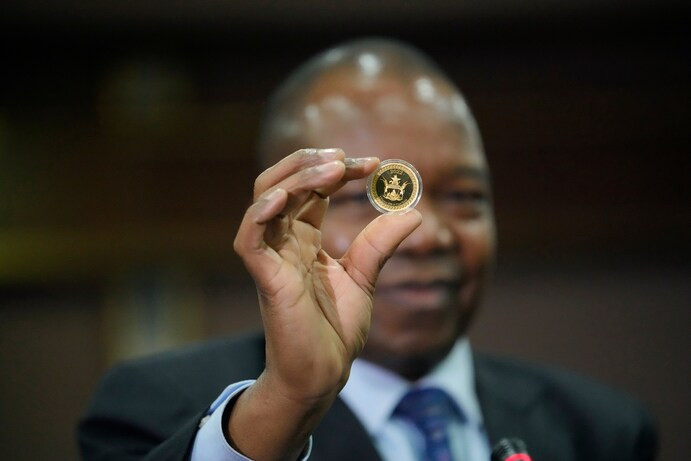
THE Reserve Bank of Zimbabwe (RBZ) has introduced several financial instruments to solve crises over many years.
These ranged from agro- and bearer cheques to bond notes and coins and to the Real Time Gross Settlement System (RTGS).
If you thought this was the end, you certainly underestimated the crisis that the apex bank is trying to solve.
The crisis got the RBZ to introduce its latest instrument, Zimbabwe Gold (ZiG).
Sometime in the middle of last year, the RBZ placed its credibility to the test by issuing Mosi-oa-Tunya gold coins.
The idea was to wipe out excess Zimbabwe dollar liquidity in the market through a 180-day vesting period, while also providing a return for buyers of the coins.
There was initial backlash from some economists in the market.
However, it appears the project was somewhat successful to the extent that smaller denominations were subsequently brought to the market.
- RBZ blocks Harare US dollar charges
- Industry cries foul over new export surrender requirements
- One stitch in time saves nine
- Banks keep NPLs in safe territory
Keep Reading
As if to build on the momentum of Mosi-oa-Tunya coins, the bank recently threw in the digital or virtual gold back tokens, ZiG, early this year.
Behold, I know what you are thinking.
But we were told that the underlying gold will be kept at the apex bank and an independent auditor will verify the adequacy of gold to back ZiG at any given time.
This virtual token was made even more accessible to economic agents, with a minimum required investment of US$10, the local currency equivalent for individuals and US$500 for corporates.
To enhance its attractiveness, an added functionality is the peer-to-peer (P2P) transaction ability.
In essence, the RBZ is anticipating that economic agents who wish to transact locally can be able to use the ZiG account, just like they do with Point of Sale (POS) machines and swipe cards.
This got people asking the question ‘so, is it a currency?’
Well, I will leave you that question to answer but certainly, ZiG is said to have the same functions as money, which are store of value, medium of exchange, unit of account and standard of deferred payment.
ZiG will be denominated in units of gold and converted to either local or foreign currency at the point of transaction.
It will still be subject to an Intermediated Money Transfer Tax (IMTT) but at half the tax of foreign currency transactions.
Individuals or corporates with physical gold could be able to redeem it into ZiG, which will be credited to their accounts.
Whether this functionality will be utilised or not is another issue, but we are told it is there. Another question that the market has, is whether you will be able to make international payments using ZiG.
Well, by simply doing a quick math that the e-wallets are opened by local banks and this is not a ubiquitous product, you can conclude that it will be confined to our borders.
However, the issuer will need to clarify that question.
Analyst’s comment
Considering that the economy, which is still transacting in local currency, continues to shrink by the day, the effectiveness of the tokens might be challenged.
There is no doubt that considering the depreciation of the local currency, an instrument that stores value will be noble.
But I opine it would have been effective a year or two ago when the levels of dollarisation were lower than what they are right now.
With less than 10% of investors in the coins being foreign currency investors, I do not see more economic agents with exposure in USD rushing for ZiG or even those with hard gold liquidating it to ZiG.
The credibility of the issuer continues to be an X-factor, provided that the Apex bank has changed goalposts on instruments it issued before.
An example is the famous 1:1 exchange rate between the US dollar and bond notes, which was then reversed via the introduction of RTGS dollars.
I see the bank having to do more to convince the market that ZiG is as good as advertised to instil confidence in the market.
There has been a trend by central banks across the world to issue what are called central bank issued digital currencies (CBDC). CBDC are a fiat currency issued by central banks.
It appears to be a direct response to cryptocurrencies, but giving the central banks control. Although ZiG does not fall under the plain vanilla definition of CBDC at the moment, due to the gold backing, it could certainly be a step towards it. The bank might use ZiG as an experiment to pave way for the introduction of a CBDC.
The advantage that a CBDC will have over gold-backed currency is the ability to influence economic development via controlling money supply, although it also poses the risk of abusing that functionality, leading to inflation.
CBDCs will also assist the bank in influencing savings if they are to be implemented at a wider scale.
I am not sure if the bank is currently thinking along the lines of CBDCs.
But this could be the opportunity to introduce one.
- Hozheri is an investment analyst with an interest in sharing opinions on capital markets performance, the economy and international trade, among other areas. He holds a B. Com in Finance and is progressing well with the CFA programme. — 0784 707 653 and Rufaro Hozheri is his username for all social media platforms.











